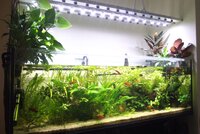sciencefiction
Member
- Joined
- 26 Feb 2013
- Messages
- 3,412
Hi all,
I have custom made LEDs that just happened to fail all of a sudden. The guy that made them has disappeared and I have no idea if I can fix them and how.
They are three separate strips of LEDs installed on aluminium bar as heat sink, each bar has with its own driver and plug so not sure why they all failed about the same time plus/minus a couple of weeks.
The LEDs he used are High Power 3W CREE XM-L's, 15 LEDs on each bar, connected to this driver model on the link below.
12-18*3W LED External power supply (AC85-265V) [JNY-L3060W-B] - $9.99 : Wayjun Technology, Focus on the production and development of LED
The symptoms are: one bar blinks, sometimes works fine. Two of the bars switch off completely, sometimes if I let them off for a while they may start and work for a couple of hours.
Has anyone got any idea what I can do?
I have custom made LEDs that just happened to fail all of a sudden. The guy that made them has disappeared and I have no idea if I can fix them and how.
They are three separate strips of LEDs installed on aluminium bar as heat sink, each bar has with its own driver and plug so not sure why they all failed about the same time plus/minus a couple of weeks.
The LEDs he used are High Power 3W CREE XM-L's, 15 LEDs on each bar, connected to this driver model on the link below.
12-18*3W LED External power supply (AC85-265V) [JNY-L3060W-B] - $9.99 : Wayjun Technology, Focus on the production and development of LED
The symptoms are: one bar blinks, sometimes works fine. Two of the bars switch off completely, sometimes if I let them off for a while they may start and work for a couple of hours.
Has anyone got any idea what I can do?



